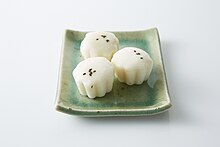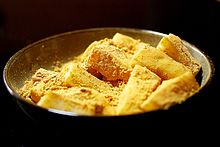Tteok
It can range from elaborate versions made of various colors, fragrances, and shapes using nuts, fruits, flowers, and namul (herbs/wild greens), to plain white rice tteok used in home cooking.
Tteok offered to spirits is called boktteok ("good fortune rice cake") and shared with neighbours and relatives.
[2] The origin of rice cakes began in prehistoric times when the coarse flour obtained from the primitive threshing process of mixed grains was baked or pan-fried without the use of cooking utensils.
Danggwi leaves (Ostericum grosseserratum), seogi mushroom (manna lichen), radish, artemisia, pepper, and cheongju are the most common flavorings, and honey and sugar are used as sweeteners.
According to steaming method, sirutteok is subdivided into two groups: seolgitteok (설기떡), which is shaped into a single large lump, and kyeotteok (켜떡), which consists of multiple layers with adzuki bean powder or other bean powder.
Seolgitteok is also called muritteok (무리떡), which is regarded as the most basic form of sirutteok because it is made only of rice.
Injeolmi, a representative of glutinous pounded tteok, varies in accordance with gomul types (고물, coating made with bean powder, sesame seeds, or sliced jujubes) or subsidiary ingredients mixed into the steamed rice while pounding on the anban.
Patinjeolmi (팥인절미), and kkaeinjeolmi (깨인절미) are examples for the former, coated with red bean powder and sesame, respectively.






